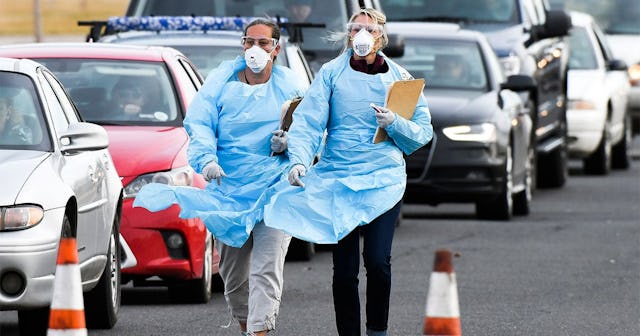14 States & Puerto Rico Hit Highest 7-Day Average Of New Coronavirus Cases

Fourteen states (or more) are now seeing a drastic uptick in COVID-19 cases, reminding us that the pandemic is far from over
This news should serve as a reminder that we are far from a place where we can let our guard down about COVID-19: 14 states, in addition to U.S. territory Puerto Rico, have shown a huge uptick in coronavirus infections. Although areas like New York that were hit hard in the beginning of the pandemic have demonstrated a decrease in cases, officials are seeing other parts of the country that were initially not as severely impacted now getting hit with a concerning increase in cases.
According to The Washington Post, which has been tracking data, 14 states and Puerto Rico have “recorded their highest-ever seven day average of new coronavirus cases since the pandemic began.” Since the beginning of June, this increase in cases has impacted the following states: Alaska, Arizona, Arkansas, California, Florida, Kentucky, New Mexico, North Carolina, Mississippi, Oregon, South Carolina, Tennessee, Texas, and Utah. Worst of all, The Post reports that “the highest percentage of new cases are coming from places with much smaller populations,” which puts a massive strain on their medical infrastructures. Small towns like the mentioned Lincoln County, Oregon, have fewer hospitals and resources and may not be well-equipped to deal with a sudden surge in COVID-19 cases.
Case in point, Arizona’s state health director sent hospitals a letter sent on June 6 “urging them to fully activate emergency plans,” according to AZcentral. Hospitals are being told that it’s in their best interests to “prepare for crisis care” and to even put elective surgeries on pause again if they’re facing a shortage of resources. And this is already happening. According to AZcentral, ICU bed occupancy has been increasing, and “that if current trends continued [ICU bed occupancy] would exceed capacity.”
In Utah, state Rep. Suzanne Harrison confirmed over this past weekend that the COVID-19 cases were growing at an alarming rate. “Today’s 18.5% positive test rate is double yesterday’s (9.4%),” she tweeted. Utah health officials are extremely worried about the uptick in cases in the state.
The number of states affected by an increase in cases might even be higher than 14. CNN reports that 22 states have seen an upward trending in virus cases. Florida has reportedly faced the most drastic spike in cases lately. CNN reports that “the number of new cases reported each day has increased an average of roughly 46 percent over the past week, just as most of the state entered a second phase of reopening.”
Another issue that The Post poses is that some states (such as Mississippi, Florida, and South Carolina), have loosened “minor-to moderate” safety restrictions and protocols over the last few weeks, even though “average daily infection rate is rising.” Most states in general have been opening up and allowing many businesses to operate with health rules in place — but experts have maintained their concern that it’s far too early to be reopening the country.
Although many health officials have warned of a second wave, the frightening thing is that this isn’t even the second wave yet — it’s still seemingly the first. According to NPR back in March, rural spots that didn’t see the virus wreak havoc on their towns at first would eventually be affected by the pandemic. “I think it’s just a matter of time,” Andy Pekosz, a professor of molecular microbiology and immunology at Johns Hopkins University’s Bloomberg School of Public Health stated — back in March. It looks like we’re currently seeing that prediction unfold.